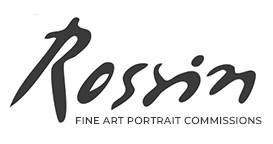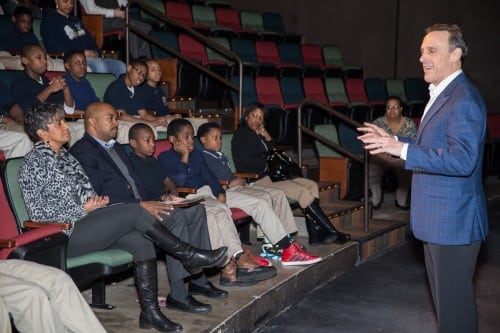The National Center for Civil and Human Rights, which opened this summer, sets out to connect visitors personally and emotionally with the stories of civil and human rights movements.
“We want to give people an itch for human rights that they have to scratch later,” says CEO Doug Shipman.
The arts plays a role in that effort, and the center is committed to partnering with artists and arts organizations in a wide variety of ways, Shipman says. Case in point: on August 15, Living Walls, an Atlanta organization working with street artists to transform public spaces, will hold a lecture series, part of its annual conference, at the center’s new facility at Pemberton Place.
Shipman explains, “We want to be a platform for artists to be able to showcase from . . . [and] we want to seed civil and human rights conversations in all kinds of places.”
Visual arts figures prominently in the center’s new building. The first thing a visitor sees on entering is a mural by graphic designer Paula Scher that reinterprets protest posters and converges around the image of a raised hand. Renowned photographer Platon’s 36-foot mural on the mezzanine depicts human rights defenders — whom he calls an “army of champions” — photographed in Cairo’s Tahrir Square and elsewhere. Portraits of human rights activists by Atlanta artist Ross R. Rossin are an integral part of the exhibit Spark of Conviction: The Global Human Rights Movement, and Selections from the Benny Andrews’ John Lewis Series hangs near the display of Martin Luther King Jr.’s papers.
Shipman describes these works as “artistic moments” that help interpret civil and human rights stories and set a tone in the building. But the center is also working concertedly to partner with a range of local arts organizations.
In truth, the center began collaborating with Atlanta arts groups, particularly theaters, long before the building opened. This winter, for example, longtime partner Theatrical Outfit held a talkback in collaboration with the center, following a performance of The Best of Enemies, written by Mark St. Germain and based on Osha Gray Davidson’s book, which gives a true account of an African American civil rights activist and a KKK member who build an alliance around school integration. The center sent a group over for a panel and discussion. The center partnered similarly with Synchronicity Theatre around its Women+War project.
The Alliance Theatre’s artistic director, Susan V. Booth, directed Speak Truth to Power: Voices from Beyond the Dark, written by Ariel Dorfman and based on the book by Kerry Kennedy, who spent years interviewing human rights defenders in many countries. Held at the Rialto Center for the Arts, it was part of the center’s 2012 groundbreaking celebration. This year Booth led a public conversation with George C. Wolfe, the TonyAward–winning director and playwright who served as the center’s chief creative officer and curated the exhibit Rolls Down Like Water: The American Civil Rights Movement.
Now that the center’s facility is open, Shipman hopes to deepen and expand its involvement with the local arts community.
“I think the center can do a couple of things in the arts scene,” he explains. “One, it can elevate Atlanta artists onto a stage that’s going to have a very broad reach, because we’re civil and human rights and we have the King papers . . . I think we can also do the opposite, which is . . . bring national figures, international figures, and have them interacting in Atlanta . . . In that interaction, lots of interesting things will be discovered.”
Shipman has held exploratory conversations with many organizations. He has discussed potential collaboration with John Q, a three-man collective that has put on multimedia performances and events addressing LGBT history in Atlanta. He has been in dialogue with Art on the Atlanta BeltLine about bringing civil and human rights themes to bear on its programming.
Noting “a very strong relationship between street artists and social movements,” Shipman reached out to Living Walls. It will be one of the first groups to hold an event in the center’s new space.
The fact that it’s a museum . . . and they’re already reaching out to, or interested in, working with a scrappy, grassroots organization like Living Walls . . . means a lot,” says Monica Campana, the organization’s cofounder and executive director.
The timing is ripe for the kind of partnering Shipman envisions. Atlanta has been a seat for collaboration among local arts organizations, particularly since the 2008 economic downturn, says Chris Appleton, executive director of WonderRoot, an organization working to inspire social change through the arts and another of the center’s potential partners.
The recession “opened doors” for artistic cooperation, Appleton explains, even between veteran and rookie organizations. WonderRoot, which he and two friends founded in 2004, has worked with the High Museum and Emory University, for example.
Appleton says he believes the National Center for Civil and Human Rights could become a “convener” in the community, bringing together leaders and constituencies who might not otherwise have access to each other. “Real, sustainable, lasting change happens when people of disparate experience come together and build consensus around values.” Regarding the center’s potential role, he explains, “I want to learn from and be advised by the resource and knowledge base here.”
Shipman says the center eventually plans to build a theater space in its facility. “I desperately wanted a big auditorium as a part of this to have performances in — it’s not there yet. It’s in the future [building] phases.”
The delay may be a boon to the local theaters with whom Shipman will work. Tom Key, Theatrical Outfit’s executive artistic director, argues that as a storytelling medium, theater creates a uniquely effective context for transformative dialogue. He says he was reminded of the power of theater while attending one of the Outfit’s post-show discussions, for Atlanta playwright Janece Shaffer’s Brownie Points, about a diverse group of mothers — stranded overnight in the woods with a troop of girls — who must face their own prejudices.
While listening, Key says he recalls thinking, “Where is there a better discussion going on in the country about race? Because we’ve all just responded to this story, we can’t hide behind our assumptions about the other.”
He says the center’s efforts out in the community help to “convene” — he too uses this term — the public around what the arts can do to address civil and human rights issues. “It’s taking these separate efforts and investments of energy in work on the progression of civil and human rights . . . pointing them out and creating this network so that we’re going to eventually begin to do together what we can’t do on our own . . . I think there’ll be tremendous shifting points in that.”

